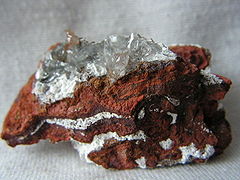- Hydrozincite
-
Hydrozincite 
HydrozinciteGeneral Category Carbonate mineral Chemical formula Zn5(CO3)2(OH)6 Strunz classification 05.BA.15 Crystal symmetry Monoclinic prismatic H–M Symbol 2/m Unit cell a = 13.58 Å, b = 6.28 Å,
c = 5.41 Å; β = 95.51°, Z = 2Identification Color White to grey, stained pale pink, or pale yellow or brown; colourless in transmitted light. Crystal habit Lathlike or bladed crystals uncommon, in fibrous, stalactitic, reniform, pisolitic aggregates; also earthy, chalky, massive Crystal system Monoclinic Twinning Contact twinning on {100} Cleavage Perfect on {100} Fracture Irregular/uneven Tenacity Very brittle Mohs scale hardness 2 - 2½ Luster Silky, pearly, dull, earthy Streak White Diaphaneity Transparent, translucent Specific gravity 3.5 - 4 Optical properties Biaxial (-) Refractive index nα = 1.630 nβ = 1.642 nγ = 1.750 Birefringence δ = 0.120 2V angle Measured: 40° , calculated: 40° Dispersion relatively strong Ultraviolet fluorescence Fluoresces pale blue to lilac under UV Solubility Readily soluble in acids. References [1][2][3] Hydrozincite, also known as zinc bloom, is a white carbonate mineral consisting of Zn5(CO3)2(OH)6. It is usually found in massive rather than crystalline form.
It occurs as an oxidation product of zinc ores and as post mine incrustations. It occurs associated with smithsonite, hemimorphite, willemite, cerussite, aurichalcite, calcite and limonite.[1]
It was first described in 1853 for an occurrence in Bad Bleiberg, Carinthia, Austria and named for its chemical content.[2]
References
This article about a specific carbonate mineral is a stub. You can help Wikipedia by expanding it.
